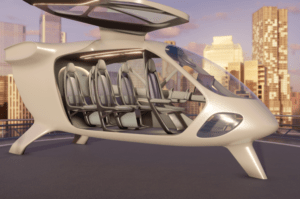
Diana Cooper is the Global Head of Policy at Supernal, a Hyundai company developing eVTOL for the commuter market. Cooper says that there are some major drivers behind the growth of urban air mobility in the APAC region: political, economic, and environmental.
“Traditional aviation has been dominated by the U.S. and Europe in the last 10 years. There is new political motivation in the APAC region to participate in this new mode of aviation and not to be left behind,” says Cooper. South Korea, China, Australia, Japan, India and Indonesia are all among the region’s early adopters of the technology – some are also home to major technology providers in the space. “This new aviation technology is relatively more accessible,” says Cooper. “There’s a feeling in this region that countries don’t want to be left out of this next phase….We have a lot of technology enthusiasts [in the region] who are ready to be first movers, to be the first passengers for this type of aviation.”
Augustine Tai is the Head of Business Development, APAC, at EVE Air Mobility, founded by Embraer. Tai says that the region is rapidly achieving economic growth – largely by moving people out of rural communities into higher opportunity urban areas. These population shifts put a strain on both housing and infrastructure development. “You can’t keep building houses without roads or roads without houses,” he says, pointing out that urban air mobility offers an alternative mode of transportation that could supplement traditional means.
“Putting up a vertiport is much less expensive than building out a system of roads and bridges and tunnels – it costs less and takes less time,” says Cooper.
The geography and environment in some APAC regions also contribute to their willingness to be first adopters of UAM technology. “UAM is about connections. We’re working in Indonesia, which is a country of more than 17,000 islands. This is a good solution for connecting these islands – there is no other really effective way,” Cooper says.
Who is Urban Air Mobility in APAC for? Premium Solutions vs. Low Cost Solutions
Panel moderator Munish Khurana, Senior Manager of ATM/UTM at EUROCONTROL, asked panelists what they expected of first use cases: luxury travel for high net worth individuals, or low cost solutions. Tai says that both are feasible in the region right now.
“We see both the commuter use case and the on-demand use case,” he says. In Bangalore, he explains, the service can be used primarily as an airport shuttle, solving a critical problem for commuters. While traffic means that the trip by car from airport to city takes about 3 hours, UAM reduces the time to 15 minutes. “That makes a huge difference for people,” he says. “It means that you can make a trip to another city for business in one day, instead of staying over.”
In other countries, the first use cases may be geared towards on-demand, luxury travel. “In Korea we have a lot of avid golfers,” says Tai. “They want to be able to get to a golf course in 15 minutes instead of spending 2 hours in the car and only being able to get in only one round.”
“They’re both strong use cases.”
Cooper says that for Supernal, they’re focused on commuter use. “We’re targeting mobility for the masses, rather than the high net worth use case,” she says. “Our design of four seats and a pilot demonstrates that.” Cooper also answers a question that has concerned many stakeholders in the UAM space – how can urban air mobility transportation be made affordable?
“For us [Supernal] what makes it more affordable is innovation: not so much on the aircraft but in the manufacturing facility. These [vehicles] are manufactured in a totally different way. A lot of the innovation is happening behind the scenes – and that’s whats going to help us make this a reasonable affordable means of transportation.”
With Hyundai as the parent company, Supernal has a unique opportunity to tap the experience and supply chain expertise of a major vehicle manufacturer – one focused on economies of scale. “Boeing can make about 300 planes a year,” Cooper points out. “Car companies can make 10 million.”
Read more:
- Supernal eVTOL Vehicle Cabin Concept Showcased at Farnborough International Airshow
- Passenger eVTOL in Japan: LIFT Aircraft Completes First Piloted Flight with HEXA
- VoloConnect First Flight: Volocopter eVTOL Travels Further and Faster
- Wisk Aero Signs Agreement to Bring Autonomous Air Taxi Program to Australia
Miriam McNabb is the Editor-in-Chief of DRONELIFE and CEO of JobForDrones, a professional drone services marketplace, and a fascinated observer of the emerging drone industry and the regulatory environment for drones. Miriam has penned over 3,000 articles focused on the commercial drone space and is an international speaker and recognized figure in the industry. Miriam has a degree from the University of Chicago and over 20 years of experience in high tech sales and marketing for new technologies.
For drone industry consulting or writing, Email Miriam.
TWITTER:@spaldingbarker
Subscribe to DroneLife here.